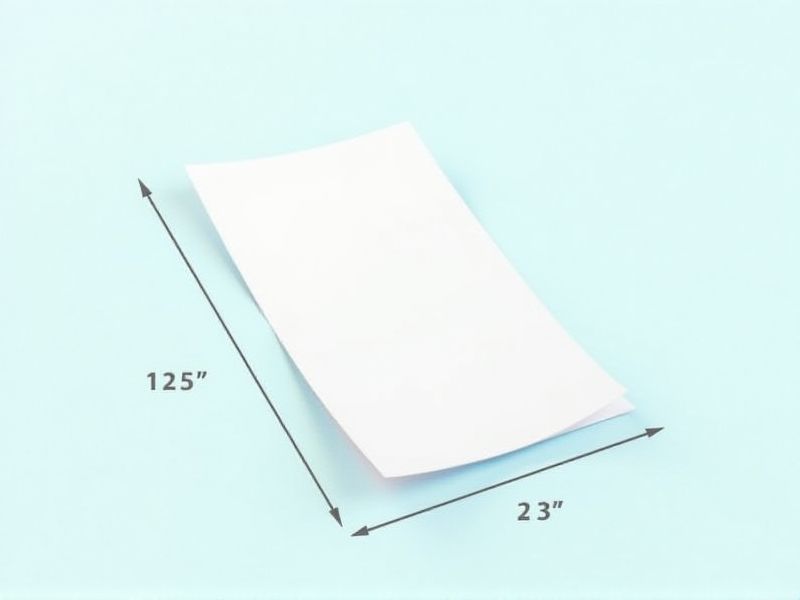
When choosing sheet sizes, it's important to consider the standard dimensions commonly available for both beds and materials. For bed sheets, typical dimensions include Twin (66 x 96 inches), Full (81 x 96 inches), Queen (90 x 102 inches), and King (108 x 102 inches). In terms of material sheets like metal or plywood, standard sizes often come as 4 feet by 8 feet (48 x 96 inches). Knowing these standard sizes makes it easier to purchase the right product and ensures compatibility with beds or building projects.
A0 Paper Size
A0 paper size measures 841 x 1189 mm, making it one of the largest formats in the ISO 216 paper size system, ideal for technical drawings and posters. The A0 sheet has an area of 1 square meter, providing ample space for detailed designs and information display. For optimal printing quality, you should use a resolution of at least 300 DPI to ensure clarity and precision. When printing or creating designs, consider the aspect ratio of A0, which is 1:1.414, ensuring that your content is well-proportioned and visually appealing.
A1 Paper Size
A1 paper size measures 594 x 841 mm, equivalent to 23.4 x 33.1 inches, making it ideal for detailed posters, architectural plans, and large format prints. The standard weight for A1 sheets typically ranges from 80 to 300 GSM (grams per square meter), balancing durability and flexibility for various applications. When designing for A1, consider the resolution of images, with a recommended DPI (dots per inch) of at least 150 for clear visuals. Your choice of paper finish--glossy, matte, or uncoated--can significantly affect the presentation and impact of your printed materials.
A2 Paper Size
The A2 paper size measures 420 mm by 594 mm, making it an ideal choice for various print projects, including posters and drawings. Often used in professional settings, A2 standard sheets provide ample space for detailed designs while maintaining an efficient layout. When printing, use a resolution of at least 300 DPI to ensure high-quality results that capture intricate details. You can enhance the visual appeal of your project by utilizing non-standard finishes and coatings, giving your A2 sheets a polished look.
A3 Paper Size
The A3 paper size, measuring 297 x 420 millimeters or 11.7 x 16.5 inches, is commonly used in professional settings for documents, illustrations, and artwork. When creating a standard sheet for A3, ensure your design accommodates its dimensions, as this size provides ample space for detailed information and graphics. Many printers support A3 size, allowing you to print documents with precision and clarity. You can optimize your layout by using margins of at least 10 millimeters to ensure text and images are well-framed.
A4 Paper Size
The A4 paper size measures 210 x 297 millimeters or 8.27 x 11.69 inches, widely used in many countries for documents, letters, and forms. With a standard aspect ratio of 1:1.41, A4 paper offers an optimal balance of width to height for professional and educational use. This format is part of the ISO 216 standard, ensuring consistency in printing and copying across different devices. When you print on A4 paper, be sure to align your content properly to maintain a professional appearance and ensure readability.
A5 Paper Size
A standard sheet focused on A5 paper size measures 148 millimeters by 210 millimeters, making it half the size of the A4 format. This size is commonly used for flyers, invitations, and notebooks due to its compact dimensions that facilitate easy handling and storage. The A5 format provides a versatile platform for both text and illustrations, often appealing in creative and educational contexts. When designing your content, consider optimizing your layout to maximize readability and aesthetics within this smaller space.
A6 Paper Size
A6 paper size, measuring 105 mm x 148 mm, is commonly used for postcards, flyers, and small brochures. When designing a standard sheet layout for A6, it's essential to consider a margin of at least 5 mm to ensure that important content doesn't get cut off during printing. You can achieve a professional look by utilizing high-quality paper weights, typically between 90 to 350 gsm, depending on the intended purpose. This compact format is particularly effective for concise messages or visual content, making it a popular choice for direct marketing materials.
Ansi Paper Sizes
ANSI paper sizes, established by the American National Standards Institute, provide a standardized measurement system for various applications, with dimensions measured in inches. The ANSI A size (8.5 x 11 inches) is widely used for letterhead, resumes, and documents, while ANSI B (11 x 17 inches) serves well for posters and architectural drawings. Larger formats like ANSI C (17 x 22 inches) and ANSI D (22 x 34 inches) are ideal for detailed technical illustrations and blueprints. Knowing these dimensions can enhance your printing and design processes, ensuring compatibility with industry standards.
Legal Size
The legal size sheet measures 8.5 inches by 14 inches, making it ideal for legal documents and contractual agreements. This format provides ample space for detailed text, ensuring clarity and readability in legal proceedings. Many offices and law firms prefer this size for its ability to accommodate extensive information without the need for multiple pages. You can streamline your document preparation by adopting the legal size standard for important paperwork.
Ledger Size
The standard sheet size for ledgers typically measures 11 x 17 inches, also known as tabloid size, providing ample space for detailed record-keeping. This dimension supports various formats, including financial ledgers, project management logs, and inventory records. Many organizations utilize this size to enhance readability and avoid crowding entries, ensuring clarity across multiple pages. Choosing the right ledger size can significantly impact your organization's efficiency and ease of data retrieval.
